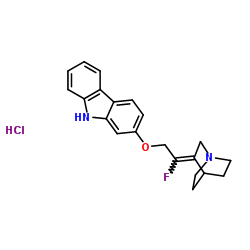| Description |
YM-53601, a squalene synthase inhibitor, reduces plasma cholesterol and triglyceride levels in vivo[1]. YM-53601 inhibits squalene synthase derived from human hepatoma cells with an IC50 of 79 nM. Lipid-lowering agent[2]. YM-53601 also is an inhibitor of farnesyl-diphosphate farnesyltransferase 1 (FDFT1) enzyme activity and abrogates HCV propagation[3].
|
| Related Catalog |
|
| In Vitro |
YM-53601 inhibits squalene synthase activities in hepatic microsomes from several species of rat, hamster, guinea-pig, rhesus monkey, and human-derived HepG2 cell with IC50s of 90, 170, 46, 45, and 79 nM, respectively[1]. YM-53601 inhibits conversion of [3H]farnesyl diphosphate to [3H]squalene by hamster liver squalene synthase with the IC50 of 170 nM[2]. YM-53601 (1 μM) potentiates the susceptibility of H35 cells to thapsigargin, lonidamine, and doxorubicin. YM-53601 (1 μM) reduces the mitochondrial cholesterol levels in both H35 and HepG2 cells[4]. Cell Viability Assay[4] Cell Line: H35 and HepG2 cells Concentration: 1 μM Incubation Time: 24 hours Result: Reduced the mitochondrial cholesterol levels in both H35 and HepG2 cells.
|
| In Vivo |
YM-53601 suppresses cholesterol biosynthesis in rats (ED50, 32 mg/kg)[1]. YM-53601 also reduces plasma non-HDL cholesterol levels in hamsters by approximately 70% at an oral dose of 50 mg/kg/day for 5 days[2]. YM-53601 potentiates Doxorubicin-mediated hepatocellular carcinoma cells (HCC) growth arrest and cell death in vivo[4]. Animal Model: Sprague-Dawley (SD) rats weighing 150-170 g[1] Dosage: 6.25, 12.5, 25 or 50 mg/kg Administration: Given a single p.o. Result: Inhibited cholesterol biosynthesis from acetate in a dose-dependent manner in rats. The ED50 value for YM-53601 cholesterol biosynthesis inhibition is 32 mg/kg. Animal Model: Five- to six-week-old male BALB/c athymic (nu/nu) nude mice[4] Dosage: 15 mg/kg Administration: 2 wk of daily treatment by p.o. gavage Result: Significantly decreased the intratumor cholesterol levels.
|
| References |
[1]. T Ugawa, et al. YM-53601, a novel squalene synthase inhibitor, reduces plasma cholesterol and triglyceride levels in several animal species. Br J Pharmacol. 2000 Sep;131(1):63-70. [2]. Tsukasa Ishihara, et al. Syntheses of 3-ethylidenequinuclidine derivatives as squalene synthase inhibitors. Part 2: enzyme inhibition and effects on plasma lipid levels. Bioorg Med Chem. 2003 Aug 15;11(17):3735-45. [3]. Eun-Mee Park, et al. Farnesyl-diphosphate farnesyltransferase 1 regulates hepatitis C virus propagation. FEBS Lett. 2014 May 2;588(9):1813-20. [4]. Joan Montero,et al.Mitochondrial cholesterol contributes to chemotherapy resistance in hepatocellular carcinoma. Cancer Res. 2008 Jul 1;68(13):5246-56.
|
